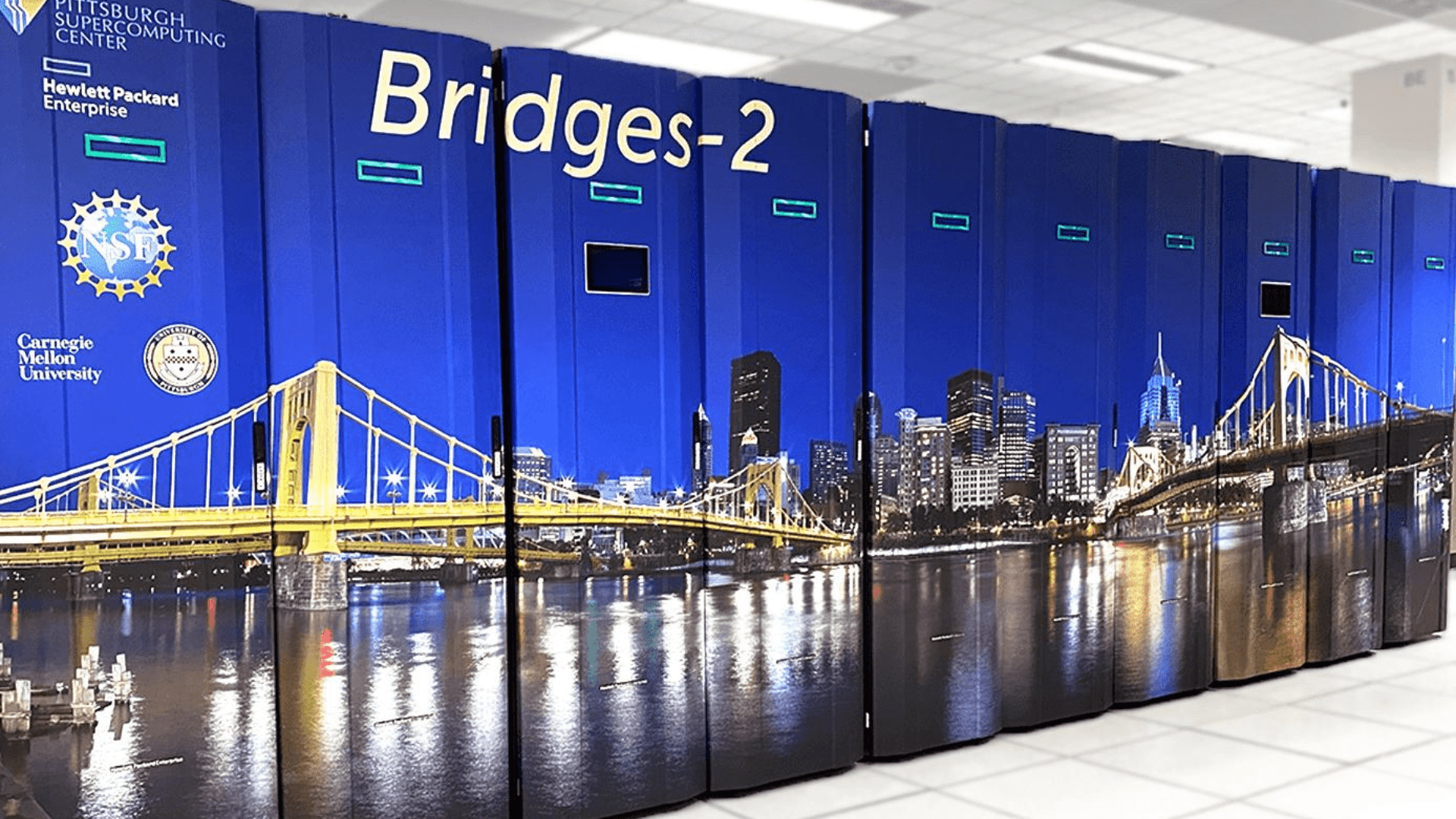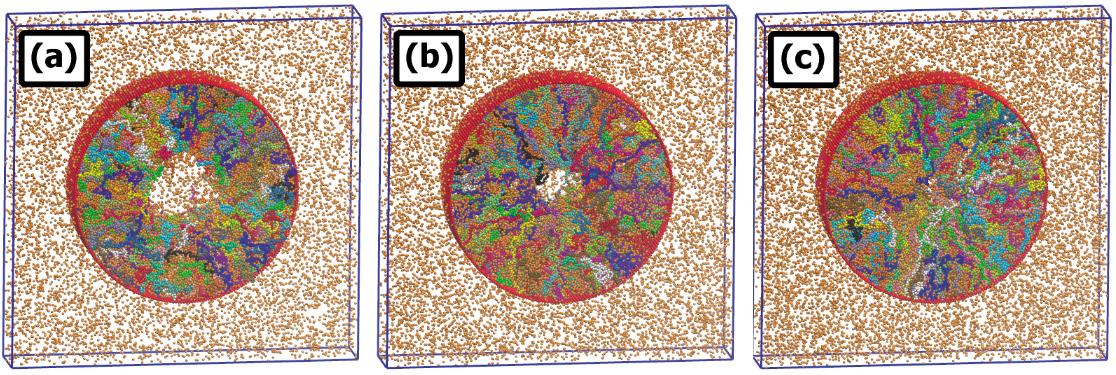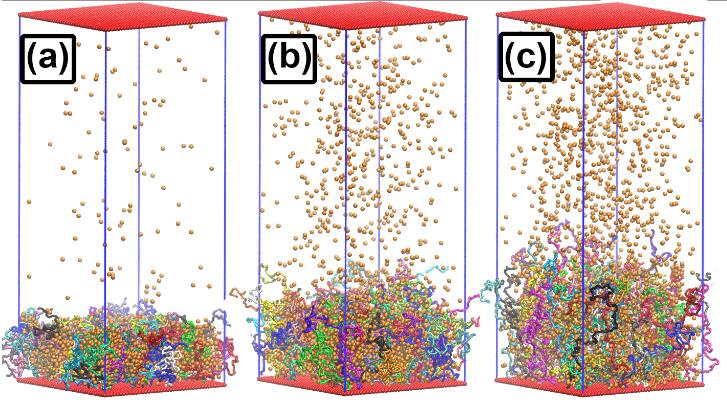
Proof-of-concept work suggests applications in industrial processes, environmental monitoring, and medicine
Polymer brushes are forests of molecular-sized chains extending from a surface. If they can be made to behave properly in the real world, they could form the basis of breakthroughs as varied as permanently lubricated machines, surfaces that sense environmental changes, and particles that deliver drugs to precise targets in the body. As a proof of concept, scientists at PSC and the University of Pittsburgh used the center’s flagship Bridges-2 system to simulate polymer brushes, demonstrating useful properties.
WHY IT’S IMPORTANT
Some discoveries start out a bit abstract, but then touch all sorts of important problems. One of these may be polymer brushes — forests of molecular chains sticking out from surfaces. In theory, for example, a polymer brush grafted onto the surface of a piston can form a permanent lubrication, allowing the piston to slide without ever needing to be oiled. Under the right conditions polymer brushes can also store and then release molecules trapped within them. This could be the answer to a longstanding aim in medicine: a delivery system that releases a drug only in the parts of the body where it’s needed, avoiding side effects.

“Polymer brushes … have very interesting applications in technology and even biology or medicine. [For example,] if two surfaces grafted with them pass over each other, they should have a very high lubricating effect.”
—Rozita Laghaei, PSC
HOW PSC HELPED
While polymer brushes ought to work in theory, the scientists knew that their performance would depend on a lot of factors. They started with temperature, seeing whether temperature changes would alter the substance’s behavior, and if so, how.
To carry out the computations, Laghaei would employ the software LAMMPS on Bridges-2. Developed by Sandia National Laboratories in Albuquerque, New Mexico, LAMMPS exactly simulates the behavior of molecules from first principles, focusing on interactions between nearby atoms in a way that allows the problem to be split into many parts that a supercomputer can solve at the same time. Bridges-2’s “regular memory” nodes — which, at 256 gigabytes per node, would actually qualify as “large memory” in many supercomputers — would be able to run the simulations quickly, generating results that the team could then analyze on laptops.
“[We] are very thankful to PSC for providing the computational resources needed for this project. For this type of calculation (running Lammps program), [we used] significant CPU resources and in this respect the AMD EPYC processors in [Bridges-2’s] RM-shared partition compute nodes are very efficient.” —Afshin Eskandari Nasrabad, Pitt
The scientists focused on polymer brushes in two different surface geometries. One was the inside of a cylinder; the other was a flat surface, with nanoparticles present in both. Simulations of the first showed that brushes that were only partially standing up at low temperatures could be engineered to extend fully at higher temperatures. Such a system could form a valve that automatically closes a tiny pipe when conditions change. In the second, flat geometry, a flattened polymer brush surface containing nanoparticles at low temperatures could be made to expand, releasing them, when the temperature increased. Such behavior could underlie a system that releases a reagent or a drug in target conditions. The team reported their results in a paper in the International Journal of Molecular Sciences in January 2023.

As temperature increases (left to right, a to c), a polymer brush coating the inside of a tiny tube expands, becoming an automatic shutoff valve. From Eskandari Nasrabad, A.; Laghaei, R.; Coalson, R.D. Morphology of Polymer Brushes in the Presence of Attractive Nanoparticles: Effects of Temperature. Int. J. Mol. Sci. 2023, 24, 832.

With increasing temperature (a to c), a partially folded polymer brush on a flat surface expands, releasing a cargo of nanoparticles. From Eskandari Nasrabad, A.; Laghaei, R.; Coalson, R.D. Morphology of Polymer Brushes in the Presence of Attractive Nanoparticles: Effects of Temperature. Int. J. Mol. Sci. 2023, 24, 832.
The work is a proof of concept that polymer brushes can be made to change their behavior when the surrounding environment changes. Next steps will include simulations at larger scales, more geometries, and more environmental triggers, as well as creating the materials in the real world to measure their properties. This will, in turn, allow them to fine-tune the simulations to suggest more real-world polymer brushes to create. Future applications could involve drug delivery, permanent machine lubrication, or automatic valves, as mentioned above. They can also include things like advanced glues; sensors for toxins, other target molecules, or changes in acidity; and a host of other smart materials.
